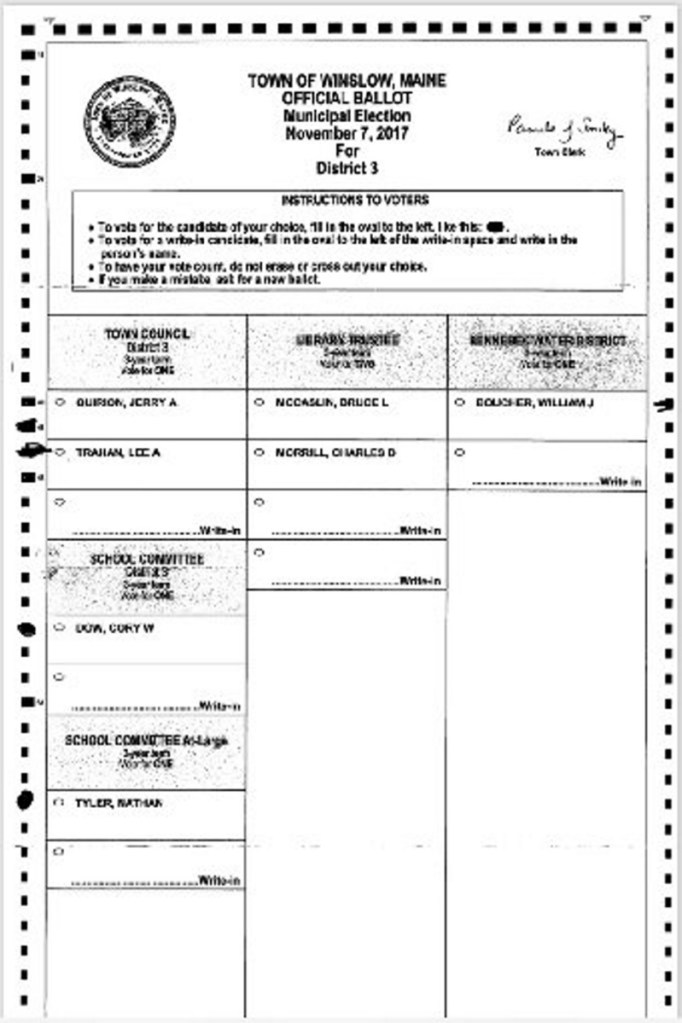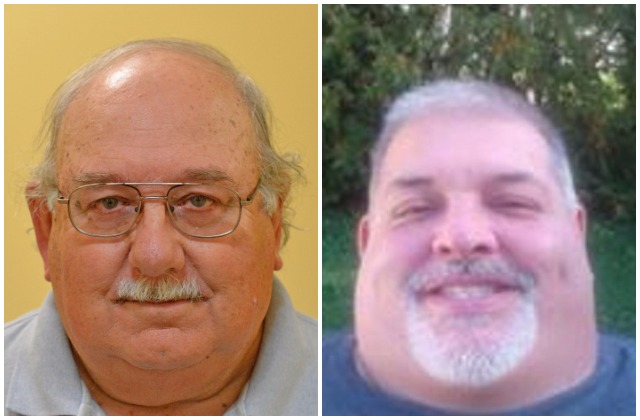WINSLOW — Jerry Quirion has been re-elected to the Town Council in accordance with to an opinion handed down Thursday from the Maine Supreme Judicial Court, in which the justices wrote that the intent of the voter who filled out a sloppy, disputed ballot could not be determined.
It is the first time the state’s high court has decided the result of a municipal election.
The decision comes after Quirion, a sitting town councilor representing District 3, questioned an election recount that his challenger, Lee Trahan, requested and that resulted in a 173-173 tie. Quirion filed a lawsuit asking that the sloppy ballot not count and that it be invalidated.
In the opinion, the justices ultimately agreed with Quirion, saying the marks made on the ballot failed to disclose the voter’s intent to vote for either candidate. Therefore, the court confirmed that Quirion was in fact elected to the council for District 3.
“I respect the decision of the Supreme Court,” Trahan said in a phone call soon after the court’s decision came out Thursday evening. “I am going to call Jerry and congratulate him.”
Trahan said he knew making the run for the council seat was a long shot from the start and that once it got into the court system, it was out of his control.
He said that he still has interest in running for the council seat in the future, as well as the school board seat he had to vacate in order to pursue a run at the council posistion.
In a news release, Quirion’s attorney, Ronald Bourget, said that although Quirion had to go through additional legal proceedings, he is grateful that the judicial process overseeing the election worked.
“In this case, every vote counted,” Bourget said in the release.
DECIDING JURISDICTION
The two legal questions the court was charged with answering were whether it could decipher the voter’s intent and whether the court even had the jurisdiction to decide a case in which there are enough disputed ballots to decide the outcome of an election. Bill Lee, Winslow’s town attorney, said that while it’s important to resolve who was the winner, the most impactful of the legal questions is the latter.
“Before the court filed this decision, there was no clear process in how to handle a disputed ballot at the municipal level,” Lee said. “The process for how to resolve (that) is now very clear.”
According to Lee, a statute that gave municipalities the authority to decide disputed ballots in their elections was repealed six years ago and replaced by 30 MRSA 2531-B, which states that municipal clerks conduct recounts but must follow the procedure outlined in 21-A MRSA 737-A. Subsection 10 of that statute states that in all elections, except those for the Senate and the House of Representatives, if there are enough disputed ballots to affect the outcome of the election, the disputed ballots are sent to the Supreme Court for resolution.
Since there had not been a case taken up of a disputed ballot deciding the outcome of an election between the time the statute was passed and Quirion’s lawsuit, the process of how to resolve such an issue was a bit unclear.
Quirion originally filed his suit in Kennebec County Superior Court, and papers were served to Lee on Dec. 6. However, when Lee read the statute applicable to the case, he said he surmised that the superior court was not the correct venue for this suit.
He asked the Supreme Court to weigh in and it agreed to review the case, but there had still been the possibility that the court would look over the case and decide it was not in their jurisdiction.
“I was happy to see that they agreed with my understanding that their court was the right place to handle the case,” Lee said. “That case settled a legal issue that was unresolved.”
Lee said he has been in touch with the Maine Municipalities Association and has kept them updated on the case. Now, since the case has been settled, municipalities can use it as a reference for how to proceed in similar cases in which a disputed ballot could determine the result and filed with the high court.
VOTER INTENT
There was no disputing that the ballot in question was filled out sloppily. The person who filled it out failed to follow directions and did not fill in any ovals next to candidates’ names, but rather made marks along the ballot’s dotted border.
The voter appears to have made marks to the left side near both Quirion’s and Trahan’s names, although the mark for Trahan is a bit larger and nudges over a boxed border a tick away from the oval.
In the court’s opinion, the justices make reference to the shape of the marks along the border as being a factor in their decision.
The court wrote, “Unlike some of the voter’s other marks in the margins, neither of these marks (beside Quirion and Trahan’s names) is in the shape of an oval or circle. The mark in the margin beside Trahan’s name is nearer to the oval, but it appears less like an oval and more like a scribble than the mark beside Quirion’s name.”
The court applied two statutes to their interpretation of the ballot. Citing the first law, the court said, “If a voter marks more names for an office than there are vacancies to be filled or more choices for a question than are permitted, the voter’s vote for that office or question may not be counted.” Quoting the second law, the court stated, “A vote will also not be counted if ‘a voter marks the voter’s ballot in such a manner that it is impossible to determine the voter’s choice.’ ”
Therefore, the court wrote, “based on the appearance of the ambiguous marks in the margin next to the boxes containing each of the candidates’ names, we find and conclude that it is impossible to determine the voter’s choice.”
The ballot could not be counted for either candidate, and the court declared Quirion the winner by a vote of 173-172.
Chief Justice Leigh Saufley sent Gov. Paul LePage the decision certifying the election.
Emily Higginbotham — 861-9239
ehigginbotham@centralmaine.com
Send questions/comments to the editors.





Comments are no longer available on this story